Demolition by neglect, arson, and ... ?
Earlier in the week in Toronto, a historic building that the owners wanted to demolish experienced a major fire. The Toronto Star's Christopher Hume (one of the best writers on urban design in North America), has a piece "Heritage remains a burning issue in Toronto." The link includes a video story as well. From the article:
The dignified red brick building, once the Empress and Edison hotels, has occupied a place in the collective consciousness of Toronto for decades. The public never wanted it to go away.
But to its owners, the Lalani Group, it was an obstacle to profitability. They had been trying to get rid of the structure for ages, and made no secret of their intentions. In 2010, they applied for a demolition permit. Given the city’s lack of commitment to heritage preservation, it would eventually have let that happen, but not without a lot of hand-wringing along the way.
Other cases have had happier endings. Think of the old Summerhill train station/LCBO on Yonge St.; it was restored by its owners several years ago and has never looked better.
The critical difference was the owners. Even if governments at all levels were serious about heritage, it’s the landlords who hold the power. Because legislation is weak and enforcement weaker, owners can get away with architectural murder.
The list of disappeared buildings is long and extensive. The most relevant was Walnut Hall, the last remaining row of Georgian townhouses that was left to fall apart by its many owners, including the RCMP. Its sad fate led to a 2007 city initiative aimed at ending “demolition by neglect.”
Landlords, good and bad, have always been with us. The point is that we have yet to figure out how to deal with properties that fall into that awkward space claimed by memory and money, public and private, cultural and corporate. Architecture is an art form as well as an economic activity. It exists in the public realm of ideas as well as the private landscape of mortgages, building codes and leases.
Demolition by neglect is a problem in DC too.
In fact, I happened to run into a friend on Thursday, and I walked her part way home down Florida Avenue NE. She commented about the empty triangle of land at the junction of West Virginia and Florida Avenues. I replied that if the owners had been required to fix their buildings, instead of encouraged to let them rot and then be demolished, then we'd have three occupied residential buildings, instead of a large empty lot.
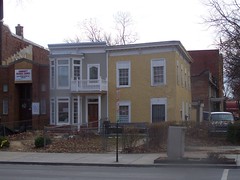
The gray building pictured in the above photo, one building east from the southeast corner of 3rd and K Streets NE was on the city's condemnation list for many many years. While I don't have a "before" photo, the building wasn't in good shape but was clearly able to be rehabilitated, as this image shows.
While the city would argue that condemnation orders don't necessarily mean demolition, but are an order to remedy nuisances, the people on the hearing board are predisposed to demolition, and there aren't many remedies in DC law to force a property owner to maintain their property (other than the higher property tax rate for vacant properties).
In honor of what happened in Toronto, I reprint this blog entry from August 2005.
Arson as a(nother) redevelopment strategem
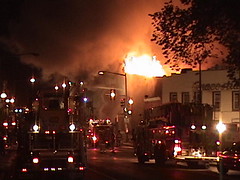
On fire--1909-1913 Martin Luther King, Jr. Blvd., Washington, DC. Fire photos from the "fire department hobbyist" website, www.dcfd.com.
-- Arson can be used to further destabilize neighborhoods. This is described in chilling detail in the book Streets of Hope about the Dudley Street Neighborhood Initiative in Boston.
-- Arson can also be used to get around historic preservation laws.
-- Arson can also be used as a tactic to get one city agency to give another city-supported agency a "problem" from the asset portfolio.
A few nights ago, some disinvested but resolute historic commercial buildings experienced a fire. Shockingly, part of the problem in putting out the fire is the fact that there wasn't water running in the fire hydrants, so that tankers had to be brought over.
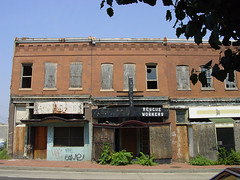
1909-1913 Martin Luther King, Jr. Blvd., Washington, DC, after the fire.
These buildings are owned by the District Government, and are in DHCD's real property portfolio. The Anacostia Economic Development Corporation has an Exclusive Rights Agreement to purchase the properties, and has submitted plans to DHCD that indicate the buildings would be incorporated into a larger redevelopment of the surrounding half-block, which has been purchased by Douglas Development. The structures are designated as "contributing" to the Anacostia Historic District, which has been identified by DC Preservation League as "threatened".
Every possible attempt should be made to stabilize the remaining portions of the buildings so that they can be incorporated into the planned new development. (Mayor Joe Riley of Charleston tells a great story of rather than acceding to the Fire Department's request to demolish a historic but burned building--they stabilized the building and closed the street--and restored the building.)
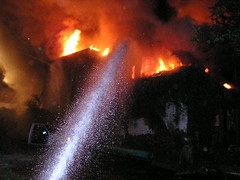
On H Street NE, four of the oldest buildings on the H Street corridor (constructed in the mid-1870s) were demolished by the local community development corporation in favor of a new building. Among other neglectful acts, these buildings did experience "fire of unknown origin."
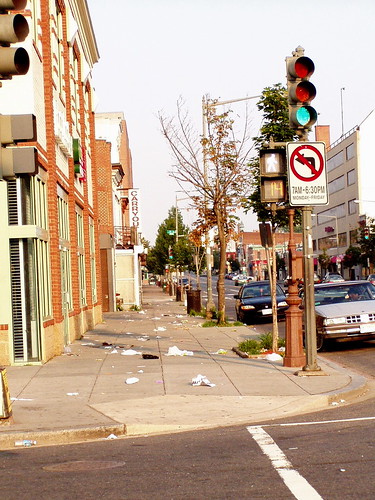
New building constructed in the place of Beuchert's Tavern and three other buildings at 721-727 H Street NE. Photo by Elise Bernard.

For decades, the corner building was the location of Club Kavakos, later the Co-Co Club, a live music establishment on the H Street corridor. Of course, this business closed after the riots. Matchbook cover scan by Peter Sefton.
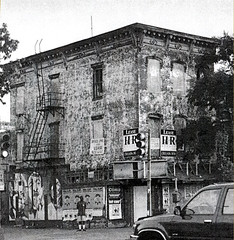
Beuchert Tavern, 727 H Street NE, pre-demolition, under the stewardship of the H Street CDC.
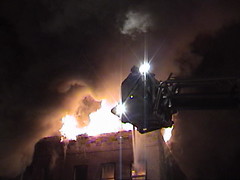
Labels: historic preservation, public safety, urban revitalization



0 Comments:
Post a Comment
<< Home